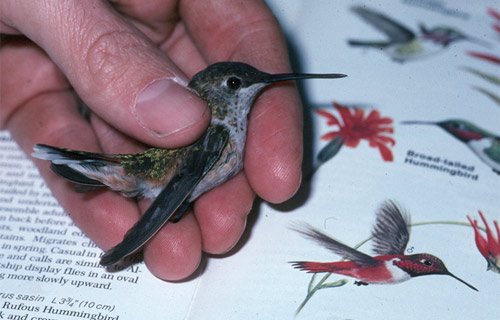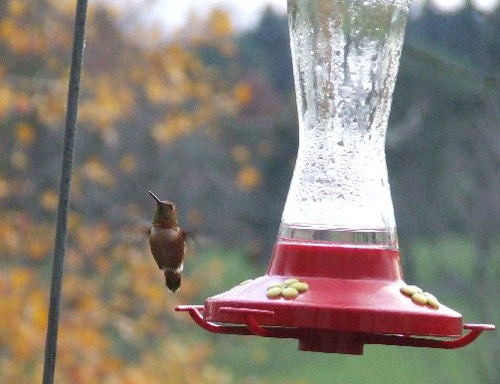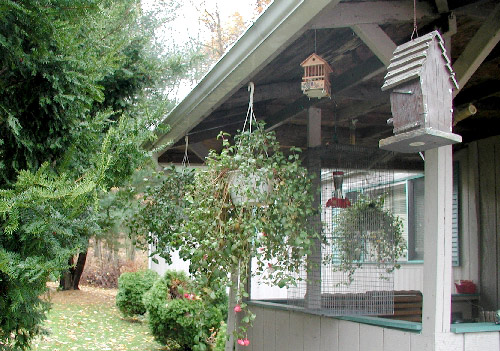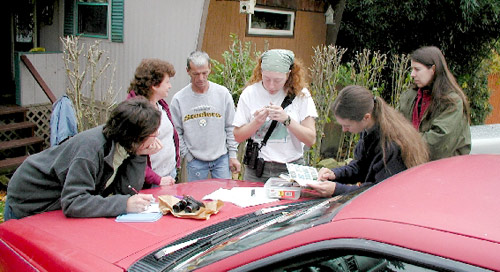
Although we have never captured a Rufous Hummingbird at Powdermill, we have banded several in western Pennsylvania.
2007
In 2007, we recaptured the very same bird in McDonald PA and another, just 10 miles away in Burgettstown, PA.
We have mentioned before about our involvement with the Hummer Bird Study Group, a cooperative banding project spearheaded in Alabama by Bob and Martha Sargent and aimed at elucidating the patterns and timing of migration of up to a dozen western Hummingbird species now known to sometimes migrate through and winter in the eastern U.S. As cooperators with this project, we are always "on alert" and "on call" to investigate late lingering hummingbirds coming to feeders anywhere in western Pennsylvania and surrounding areas (colleagues of ours cover the middle and eastern parts of the state). By far, the most commonly encountered western species in the East is the Rufous Hummingbird.

We answered the call to investigate two late hummers still coming to feeders in November. Truthfully, we had tried but failed to catch one of these (a suspiciously very wary and wily bird coming to Ray and Eydie Posel's feeder in McDonald, PA, in mid-October) on our first try, but we succeeded on November 2 in trapping the bird at a feeder belonging to the Posel's nextdoor neighbor, Kim Sartori (pictured to the left with Adrienne Leppold just before releasing the bird).

The story of this bird actually begins last November, when we trapped it at the Posels only to discover that it was already wearing band no. N-71927. We shortly learned it had been banded the winter before in Diamondhead, Mississippi.
The Posels last saw it on 12/19/06, when it presumably continued on its southward migration toward its wintering grounds (Diamondhead, MS again?). Doubtless it migrated back to its Rocky Mountain nesting grounds this past spring, afterwards migrating southeast once again and finding its way to a migratory stopover site at the very same house and feeder in southwestern Pennsylvania! Amazing as this story of survival and navigation may seem, it's nothing compared to the saga that our good friend Bill Hilton tells of a Rufous Hummingbird that returned this year to the same South Carolina home and feeder to spend its fifth consecutive winter! (Read the whole story, illustrated with Bill's always excellent photos).

We caught and banded a second Rufous Hummingbird on 11/21 at Patti Briggs' house in Burgettstown, PA (interestingly, just 10 miles or so west of McDonald, PA, where we recaptured N-71927 on 11/2--makes us wonder just how many of these birds sneak through on migration unobserved!).

Pictured here are Patti, her daughter Kate, and Adrienne Leppold with the second RUHU, an HY female banded with E-49783. Designed by Bob Sargent, the special wire cage trap that we use for our targeted hummingbird banding (with a hummingbird feeder suspended inside it as bait) is visible in the background.
2006
Two more Rufous Hummingbirds were banded in 2006. The first in September in Gibsonia, PA, the second, in November was a recovery captured in McDonald, PA.

Our first capture of a Rufous Hummingbird was at a feeder near Gibsonia, PA on 19 September, a day after the homeowners saw their last Ruby-throated Hummingbird. There was no mistaking that they had something different and they were correct in knowing it was special.

After familiarizing themselves with our website and learning about the important research we're helping to conduct on these interesting little birds, they graciously extended an invitation for us to come out and try to catch, what we were pretty sure at this point, was an adult male Rufous Hummingbird. After waiting and watching the bird perched in a nearby tree for about 10 minutes...

...it came right down to the feeder and right into the trap. Success!! A very strong, healthy, and handsome adult male Rufous Hummingbird. As we have observed with quite a few of the other RUHU's we've banded over the last three years, he was actively undergoing molt, which was nearly complete. P8 was still in sheath and only P9 and 10 had yet to be replaced. As with most hummingbirds, it is thought that their prebasic molt occurs on the wintering grounds. Evidence, at least in the case of these easterly Rufous Hummers, is beginning to suggest, however, that when conditions are favorable, they will halt their migration and commence, if not complete, their prebasic molt well before arriving on the wintering grounds.

As has become tradition, the homeowners got the honor of releasing the bird post banding. Thank you for your very important contribution and support of this research project.
The last report we received on little E-49556 was that he was observed feeding excessively on Thanksgiving Day (weren't we all!) and was last seen for one final feeding before heading farther south on the morning after Thanksgiving, Nov. 24.

While a report of a Rufous Hummingbird in late November is no longer unexpected in our region, we certainly didn't expect to discover one that was already banded!! Yes, the second RUHU we caught this year turned out to be our first foreign recovery!!
This adult female captured on 22 November in McDonald, PA was originally banded in Diamondhead, MS on 25 January 2006 by Mark Myers. It showed up at Ray and Edyie Posel's house around 20 October and was the first record of this species for Washington County, Pennsylvania. It is also one of just a few recoveries of a western hummingbird species in the northeastern U.S. and the first foreign recovery of a Rufous Hummingbird in PA.

Many thanks to Bob and Martha Sargent of the Hummer/Bird Study Group who first began efforts to band these "western" hummingbirds in the east, and for enlisting other banders, such as Mark and ourselves, to contribute to this now very widespread effort.
N-71927 certainly added an important piece of information to our understanding of the migratory routes and timing for these eastern Selasphorus sp. While the exact breeding grounds for this individual is still unknown, our recovery strengthens speculation that birds caught in the Northeast are, in fact, stopover migrants on their way to the southeastern U.S. for the winter.
In this photo, Bob Mulvihill hands our special catch of the day to homeowners Edyie and Ray Posel for the release.

Thank you Ray and Edyie for your hospitality, your invitation for us to come and catch what turned out to be a very special bird, and, last but not least, for your enthusiasm.
2005
In 2005, we banded two more Rufous Hummingbirds in South Connellsville and in Hopewell, PA.

November 9 was made into a short banding day at Powdermill so that we could travel about 20 miles away to the home of Joanna Adams and Chuck Sherwood in South Connellsville, where a hummingbird had showed up at their nectar feeder a few days prior.
Actually, this was the same house where we banded an adult female Rufous Hummingbird last November and where a probable Rufous (but never caught and banded) wintered in 2003. We fully expected that our trip this time would result in the recapture of the female banded last year, but, to our surprise, it was an unbanded immature male Rufous this time.
We're not sure what makes Chuck and Joanna's home so darn attractive to wayward hummingbirds--maybe they use a mixture of three, instead of the usual four, parts water to one part sugar recipe!

Left to right: Cokie Lindsay, homeowners Joanna Adams and Chuck Sherwood, Adrienne Leppold, Felicity Newell, and Pam Ferkett banding and processing an immature male Rufous Hummingbird that was trapped in less than ten minutes when it went straight to the nectar feeder, which had been relocated inside a large wire box trap.

The HY male RUHU banded at South Connellsville on November 9, 2005.

While not banded at Powdermill, the following bird easily qualifies as the top highlight for the second half of November, and certainly gave us all something to be thankful for at the end of Thanksgiving week.
On Sunday, November 27, we traveled to the home of Rich and Elizabeth Hoge in Hopewell, PA (Beaver County) to trap and band a probable Rufous Hummingbird. Upon arrival, we were greeted by a pair of very welcoming, bird-loving homeowners who quickly pointed out the hummingbird, sitting at the tip-top of a nearby tree, eyeing us and the feeder. We patiently waited, and about 25 minutes after hanging the feeder inside our trap...SUCCESS!

The hummingbird finally flew in the trap to feed, and we had caught our second Rufous Hummingbird for the year.
It proved to be an adult female that had actually been visiting this feeder since about October 15th.

It is worth mentioning that aside from the adult male attempting to winter near Erie, PA that we caught and banded last fall, most of the other late fall hummers that we have banded or received reports about have been hatching year birds (i.e. young of the year) or adult females. A possible reason for this bias might be there is a differential migration between sexes in this species. As Scott Weidensaul, an acclaimed author, ornithologist, and hummingbird bander for the eastern part of the state, mentioned recently on the Pennsylvania Birds listserv, adult male Rufous Hummingbirds may very well be migrating up to a month or more earlier than females and young of the year.
This has some support from some unconfirmed (positive identification of this species can only be done with the bird in the hand) reports of probable RUHU at feeders in the eastern U.S. as early as August. If this is the case, adult males are overlapping their migration with the time many hummingbird feeders are also swarming with flocks of migrating Ruby-throats (the common eastern breeding resident hummingbird species) and may simply be being easily overlooked. These earlier migrants also may not linger as long at feeders.
For this reason, we encourage readers in the eastern U.S. to remember to watch their feeders in coming seasons as early as August for truly "different looking" hummingbirds. Rufous Hummingbirds of any age and sex have a noticeable amount of rufous at the base of the tail (see photo below). If you should see such a bird, please contact us right away (if you are in western PA and surrounding areas) or visit the Hummer/Bird Study Group website for more information about this study and for hummingbird bander contacts outside of western PA.

Thank you to Elizabeth Hoge for contacting us about her tiny, late fall visitor, and thanks to both her and her husband, Rich, for inviting us to come to their home, catch and band the bird, and add one more piece to the complex and fascinating puzzle of "western" hummingbirds migrating and wintering in the East. When we band hummingbirds away from Powdermill, the honor of the release always goes to the homeowner, in this case Rich (but not before a quick "Thanksgiving family photo").
Comparison of Rufous Hummingbirds


HY Male is top photo.
AHY Female is bottom photo.




Comparison of tail patterns of HY male, HY female (banded in Ligonier, PA September 2004), AHY female (same as above), and AHY male (banded in Erie, PA November 2004)


Comparison of back coloration of HY male (top) and AHY male (same bird as discussed as above)--both birds were in active wing and body molt in November


Comparison of HY male and HY female (same as above) head plumage--both birds actively molting wing and body feathers.
2004
We banded two Rufous Hummingbirds in 2004, one in Indiana PA and the other in Erie, PA.

November 15, Erie PA
We banded our second Rufous Hummingbird this fall! After having heard reports for a couple weeks of a Rufous visiting a feeder near Erie, we finally arranged to travel north to East Springfield in Erie County. Once there, we were greeted by homeowner, Arla Parmerter, along with visiting Pittsburgh birder, Carlton Schooley, and, within minutes, by the visiting "guest of honor," the adult male Rufous Hummingbird in the photo to the left.
Mrs. Parmerter told us the hummingbird had first arrived at her house on October 20th and since then had attracted a lot of attention from people all over the state.

In the photo shown here, Bob Mulvihill tells Mrs. Parmerter and Carlton how banding N-43573 can contribute to the study of these interesting birds. By adding one more individual to the population of banded Rufous Hummingbirds migrating or wintering in the eastern U.S., there always is the possibility that it may be seen and captured by one of many in the network of banders involved in the Hummer/Bird Study Group (or return to Arla's house next year!) and that we will learn an important new piece of information about the species' survival and movements.

N-43573 was weighed (3.5g), measured, and molt data was taken. Interestingly, like the bird we banded in late September of this year, he was molting his primaries and secondaries, his outermost 5 retained primaries (yet to be dropped) showing extreme wear.

To Mrs. Parmerter, who's bird-friendly backyard provided the oasis for this tiny traveler, went the honor of releasing N-43573.


November 16: Normal banding operations were underway at Powdermill when we received a phone call around nine o’clock from Mr. Gordon Hollingsworth of Brush Valley, Indiana County (about 20 miles north of Powdermill).
He thought he’d been seeing a hummingbird in his yard for a week or more but wasn't sure he believed his eyes, or at least that anyone else would believe his eyes! When he told his brother, his brother remembered having read an article we published in the local paper a few weeks before in which we specifically requested that anyone who saw a late hummingbird call the Powdermill banding lab right away!
That’s just what Gordy did, and we hurriedly closed nets, banded what birds we had, and headed straight for Brush Valley. Could it be....two Rufous Hummingbirds in two days?!

In the photo here, homeowner, Gordy Hollingsworth (left) and neighbor Charlie Stern (right) pose for a quick picture with N-43574 (hummingbirds usually will lie still on their backs for a photo like this until they're rolled over) before sending her on her way.
